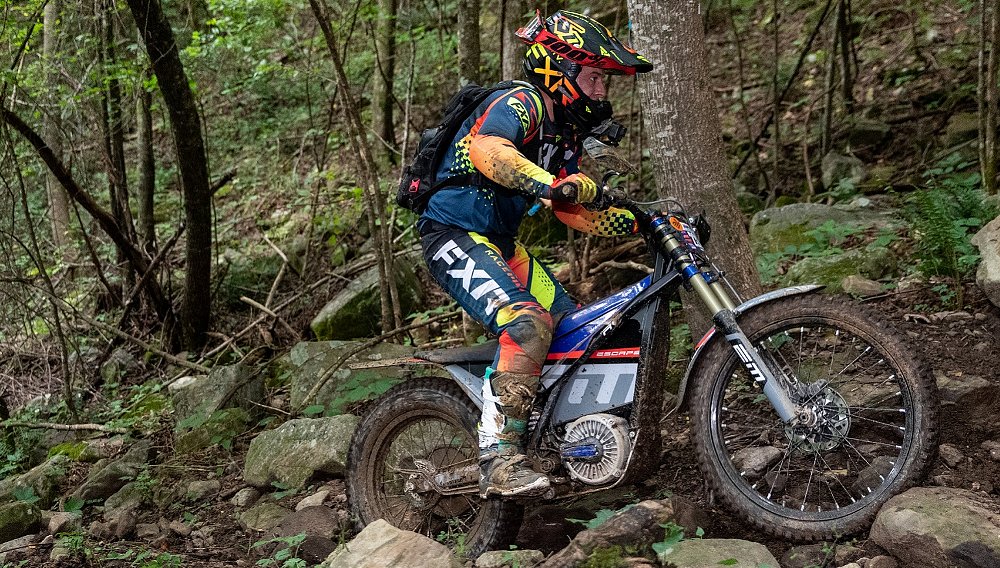It's easy, when talking about electric motorcycles, to walk right past the rhinoceros in the room.
The big horny critter with the bad attitude is this: There will come a time when you will not be able to buy a new, internal-combustion-engine motorcycle. That time is likely to be a lot closer than you think it is.
Manufacturers hate having to make different products for different markets. If a political jurisdiction represents a large enough share of the market, manufacturers will meet the market or regulatory expectations of that place, and the rest of us get dragged along for the ride. In the simplest terms, if California or the European Union want something, we all get that thing.
California has already passed a law that will end the sale of internal-combustion lawn equipment in the state at the end of 2023, and new gasoline-fueled cars will not be available stating in 2035. Do you really think that the same people who wrote those laws will look at your single-cylinder dirt bike or your 100-cubic-inch V-twin cruiser and decide to give them a pass?
So the rhinoceros' new question is not if you'll get electric motorcycles, but what kind of motorcycles they'll be. And truthfully, that's where the fun begins.
Because if you accept that motorcycles — or any other vehicle, for that matter — powered by electricity do not have to be e-versions of today's internal-combustion motorcycles, that realization is profoundly liberating.
In the United States, our interstate highway system has created a kind of technical evolutionary process where the end results are unnaturally selected to go 80 miles an hour for 200 miles. Not every machine has to meet that spec, however.
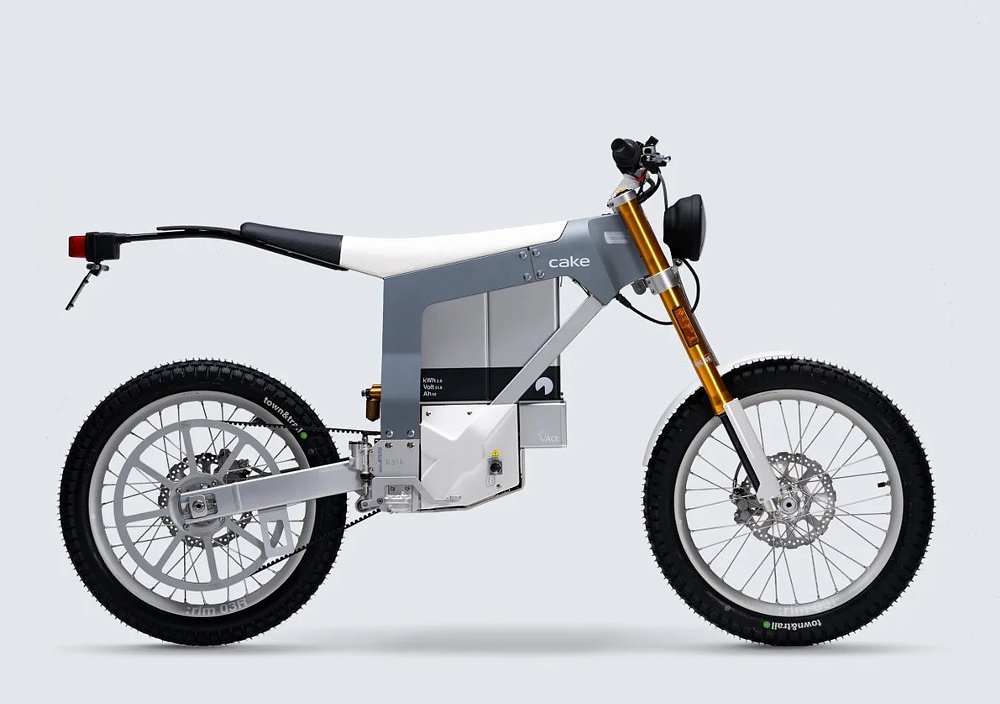
Smaller, lighter, more efficient
CAKE 0 Emission AB of Stockholm, Sweden, is one company that has come to the enlightenment of being lighter. CAKE's Kalk& dual-sport bike, which weighs 175 pounds, benefits from not having to cart around 350 pounds of battery pack that some other electric motorcycles do.
The Kalk line is based on a common dirt bike platform. The aluminum twin-loop perimeter frame is constructed out of rectangular section tubes. Much of that attractive structure is hidden, sadly, by a pretty robust system of plastic bash covers and bodywork, and complemented by a suitably robust skid plate that protects the electric motor and the lower frame rails.
That very rigid structure has long travel suspension at either end. The street-legal Kalk& variant I tested had a fully adjustable Öhlins inverted fork out front paired with a fully adjustable Öhlins monoshock that provides nearly eight inches of travel. Wheels are 19 inches front and rear. The off-road models come with Kenda Trail Saver knobbies, while the street-legal models sport Town&trail tires whose pattern looks like a traditional trials tire. CAKE doesn't list a ground clearance spec, but it's healthy.
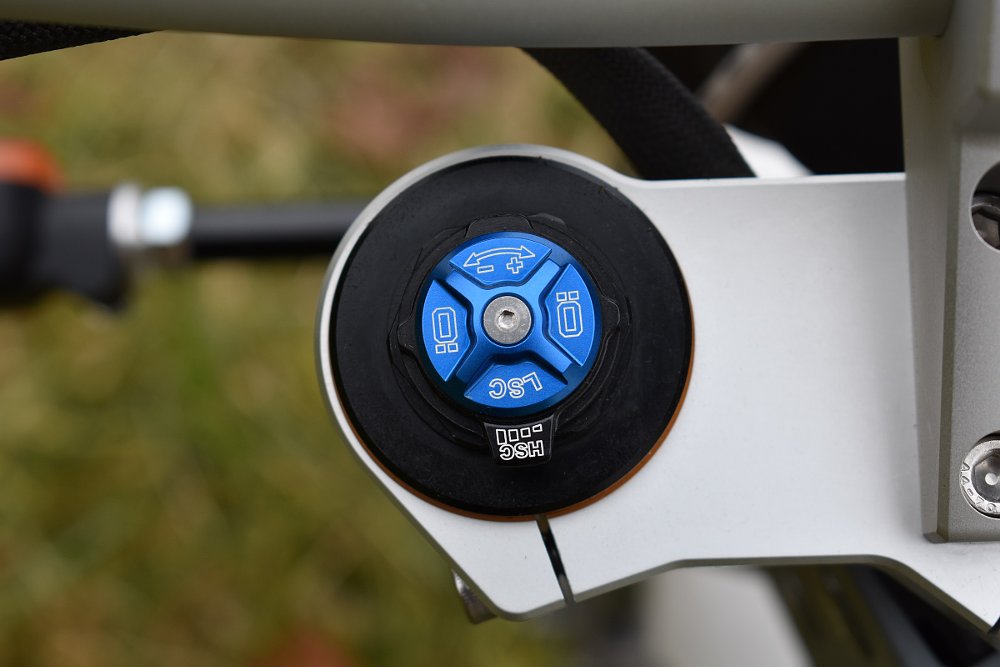
Braking at both ends is accomplished via four-piston CAKE alloy calipers and braided stainless steel lines. The front is progressive and powerful. If you want to stand the bike on its nose under braking, it's easily done. The rear is similarly powerful, but its beautiful and diminutive alloy pedal it tough to modulate. If you're the kind of rider who loves to "back her in" with the rear wheel locked and sliding on the dirt, this is your rear brake.
Specs don’t really capture the nature of the Kalk&. With the exception of the footpegs and handlebar, the Kalk& appears to be a uniform eight inches wide from end to end. The design aesthetic is super modern and ultra-minimal.
The Kalk& gives off a "dirt bikes from outer space" vibe. The large, narrow wheels with knobbies, the crazy amounts of empty space between the tires, and a certain insect-like appearance simultaneously project lightness and great strength. Almost the entire upper surface of the motorcycle is technically saddle. If Ziggy Stardust's Spiders from Mars had motorbikes, they'd look like this.
On a detail level, the Kalk& is machined metal jewelry. Literally. Many components are machined out of aluminum billet. Spend a little time looking at details like the Kalk&'s upper and lower triple clamps, handlebar clamps, the wide and studded footpegs, or especially the wheel hubs, and you see evidence of a designer obsessed with small details.
It's hard to wrap one's head around how something so clean could have been intended to get so dirty.
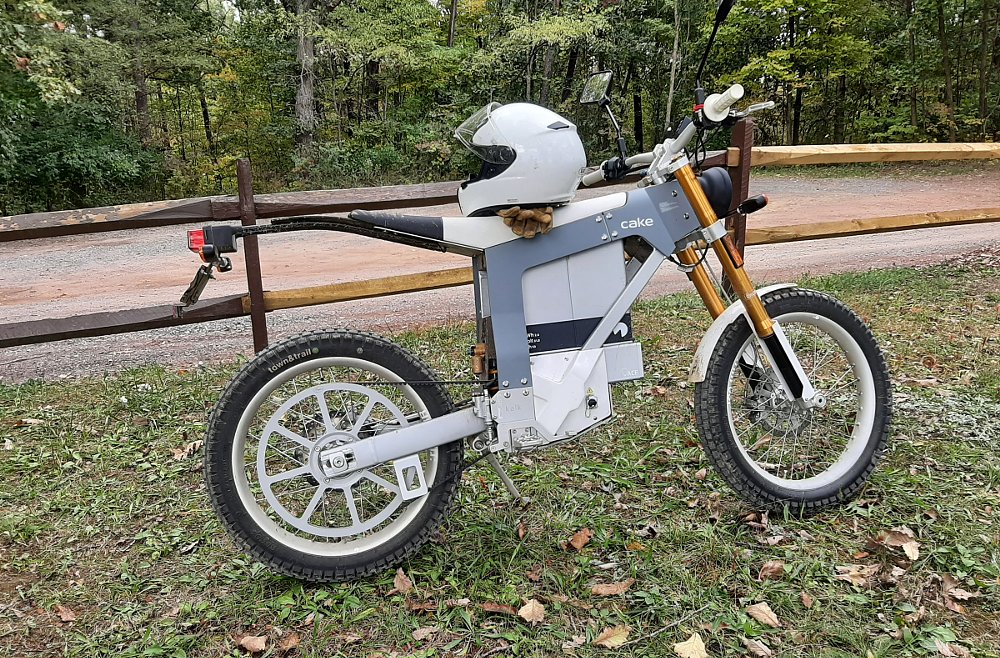
Riding the Kalk& — and getting it dirty
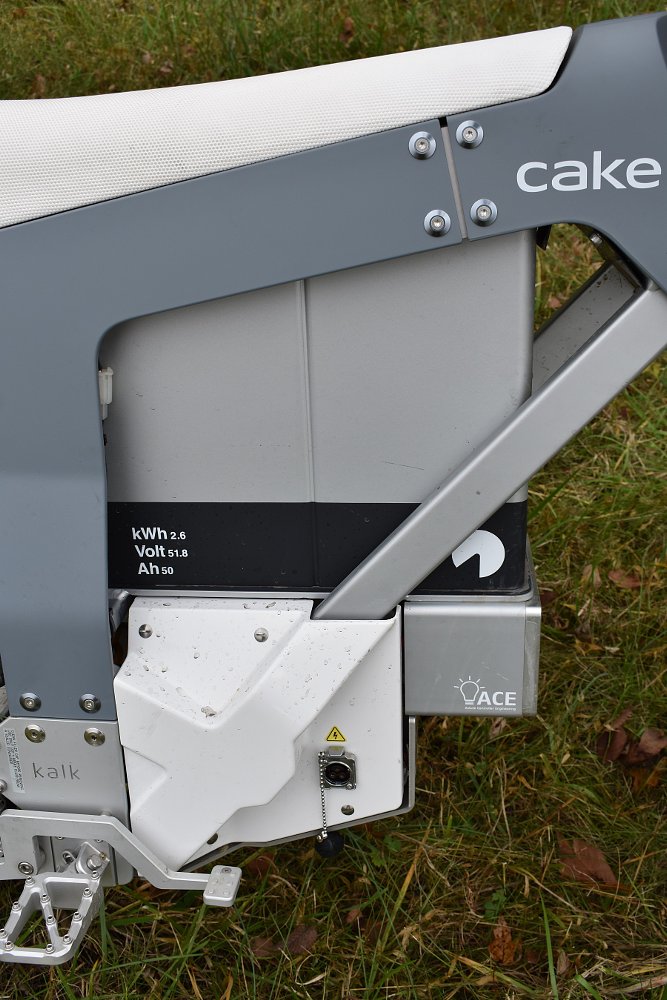
Both models have an easily swapped battery. The company sponsors the CAKE Worlds off-road racing series and racer types have the option of keeping a second 2.6 kWh cell on the external charger, and swapping in the charged one as needed. Street riders can remove the battery for charging at a more convenient location. Battery removal is fast and dead simple: Two five mm Allen bolts secure the saddle to the top of the bike, and two more long Allens secure the battery to the motorcycle's structure. Remove those, undo a small control cable connector, lift straight up on the web strap, and the 38-pound battery pops clear of the motorcycle. With a little practice, it's a three-minute swap.
To ride the Kalk&, one presses a sanitary looking chrome "On" button located on the bike's upper surface just behind the steering head. After the bar-mounted LCD display boots up, enter a preset PIN to get the bike's ready screen. The display is simple and concise. There's a big digital speedo, a small battery charge state icon in the upper right, a combination odometer and trip meter in the upper left, and two mode selection numbers down the right side. Minimal.
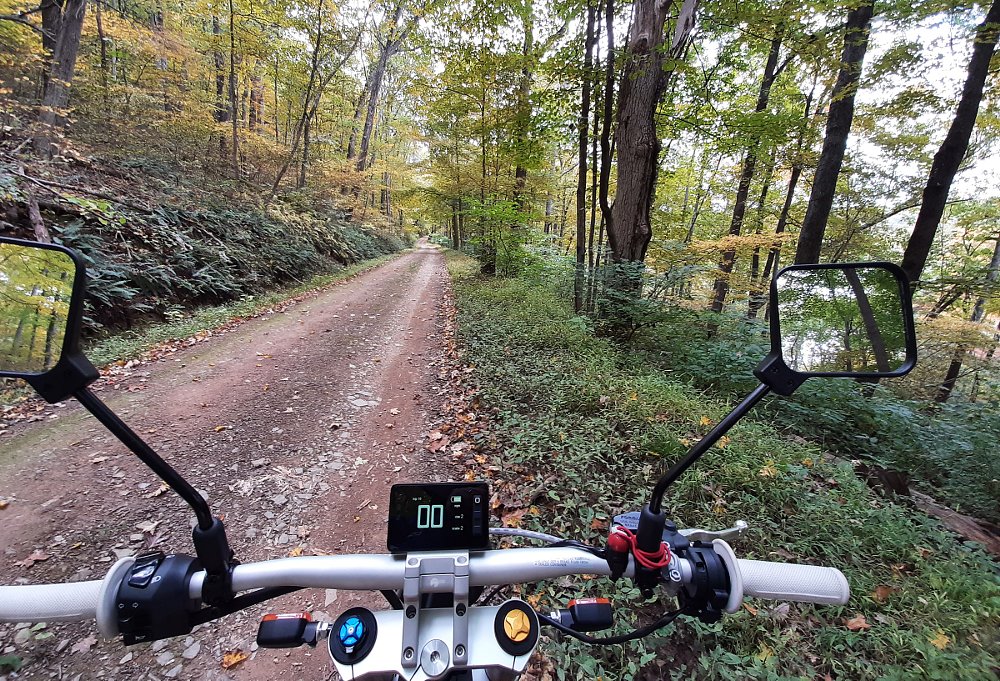
There are three drive modes. Mode 1 is "Easy," a low-power mode limited to 28 mph. Mode 2 is "Medium" and is still limited to 43 mph. Mode 3 is "Full" and takes the gloves off. The CAKE documentation says this mode "is recommended for highly skilled riders only." The rider has access to the full power of the motorcycle, but due to the extremely short gearing CAKE claims a top speed of 56 mph.
Top speed, though, is absolutely not what the Kalk& is about. Tenacious handling, crazy levels of agility, and a narrow, light machine that wants to live in the space that used to exist in between a motorcycle and a mountain bike, but apparently doesn't any more — those things are what the Kalk& is about.
Plenty of hairy-chested, big-bore dirt bikes and adventure bikes are fast, but many of those bikes are heavy, can take a while to boost their bulk to speed, and can be challenging to safely manage when they get there. The Kalk&, on the other hand, is quick, due to its light weight and instant torque. Between about 25 and 45 mph, the Kalk& accelerates almost relativistically — one millisecond you're here, and the next millisecond you're gone.
In addition to the three drive modes, the Kalk& provides three regenerative modes, which provide the feel of engine braking on an internal-combustion vehicle but with the added benefit of recharging your battery under deceleration. In Mode 1, if you close the throttle the bike basically freewheels. Mode 2 slows gently. It's useful for setting corner entrance speeds. Mode 3 is "brick wall" mode — like slamming the throttle shut on a 650 cc single. It is not subtle. All three settings can be useful under the correct circumstances.
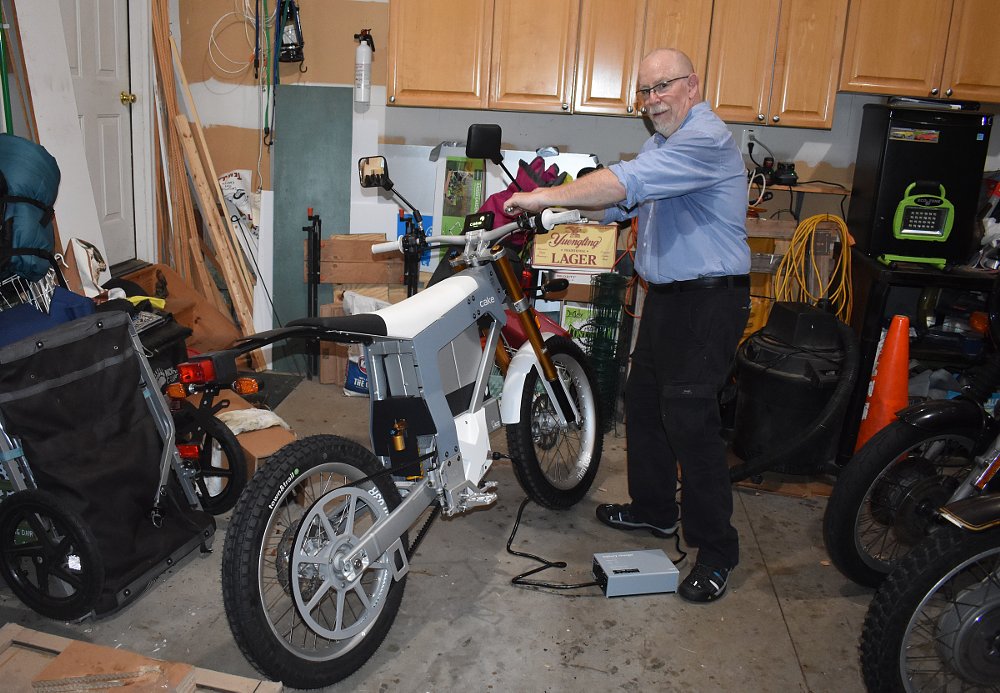
With its 36-inch seat height, getting aboard the Kalk& and getting underway requires a little altitude. I'm five feet, eight inches tall and I quickly got into the habit of booting up the Kalk, putting my left boot on the footpeg, rolling the throttle gently open, and then swinging my other leg aboard after the whole system was in motion. It was way easier than trying to loft my leg over that very tall tailsection while standing on the ground. Getting off proved to be the same trick in reverse. Once aboard, I could get both balls of my feet down, but the on and off transitions were a bear.
Rolling in Mode 1 is an exercise in subtlety and utter silence. The ability to precisely control torque and engine braking with the direct-drive electric powertrain allows low-speed maneuverability that is hard to conceive of on an internal-combustion bike. In Mode 1, the Kalk& is a big, friendly, over-engineered electric bicycle.
In Mode 2, though, the Kalk becomes a motorcycle.
I tested the Kalk& on the network of unpaved roads, forest tracks, and water crossings in rural Maryland near where I live. The first 50 yards on Poffenberger Road — my favorite unpaved farm road, with a crushed limestone surface — were a complete flash of enlightenment. Off pavement, the Kalk is a sharp weapon. All of the tricky, technical stuff that quickly shines a light on the limitations of larger off-road motorcycles, were conditions the Kalk& simply laughed off.
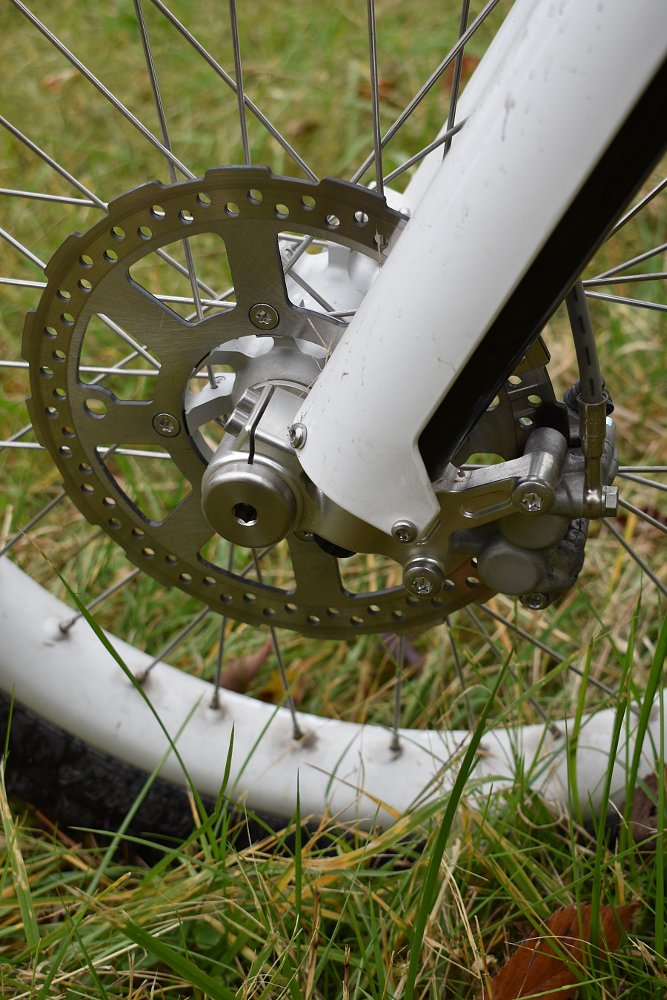
But stand up on those wide, studded footpegs, move your weight toward, and twist that thing we used to be able to correctly call the throttle, and the Kalk& handles off-road surfaces like it has tentacles. Structural rigidity and Öhlins combine to keep both wheels tracking under all conditions. You want to cut hard against an off-camber, loose, rutted surface? Do it now. Zero drama. Blow a line? Just grab the handlebar and fling 'er back. Come to a grade that comes off a little gnarly? Stand up and "gas" it. Stay hooked up and moving forward with zero chance of stalling. It's almost like cheating.
That "stay hooked up" thing is something we should touch on. The Kalk& motorcycles have no e-nannies of any kind. There's no IMU, no ABS, no traction control — there's just you and that lever, Snorky, like God and Davidson intended.
When I saw the torque spec that Cake provides — approaching 200 foot-pounds at the contact patch — I'll admit I had concerns that the Kalk& would be some brutal, dirt-flinging wheelie monster. Blink hard and I'd be wearing it for a hat. Reality is more manageable. The Kalk& manages to hook up with more or less everything it's putting down, converting each Nm of output to forward motion.
No one is going to confuse one of these lightweight electrics — which accelerate in utter, misleading silence — with the fire-breathing 650 cc dirt bikes of memory or a modern 450 cc motocrosser. The entire Kalk experience is quieter, cooler, smoother, and altogether more refined. But come sliding out of a 25 mph corner in Mode 3 and wind the right grip open, and the stylish little motorcycle transitions from here to there without a chance for one's mind to process the change. The traditional motorcyclist expects such spatial transformations to involve quite a bit of vibration and of noise. That all the Kalk& provides is a high-pitched whine from behind the toe of one's right boot gives the mind that much less to work with.
Editor's note: For another, more street-oriented perspective, see Zack's Daily Rider episode featuring the CAKE Kalk& below.
Living with the Kalk&
I was lucky enough to have the Kalk& around for a couple of months. The longer it was here, the more thorough I was able to be in finding progressively tougher terrain to ride it on, wandering further from my customary rides.
On the topic of wandering, though, one thing one won't be doing with the Kalk& is touring. The bike’s small battery and crazy low gearing are just not happy at any kind of sustained speed. But at the kind of speeds you'll expect when riding dirt roads or trails, the bike is able to deliver just over 50 miles of range. That should give you two or three hours of backwoods thrashing that will likely leave the rider needing a recharge along with the Kalk&.
The Kalk& uses an external charger that plugs in to any 110- or 220-volt outlet. CAKE says the bike will charge from zero to 80% in two hours. There's no DC fast-charging capability, so you won't be trying to go further by stringing together charging stations. Given the range, that wouldn't be practical, anyway.
What all this means is that my test routes maxed out at about 35 miles because of the need to ride public roads to the good stuff. Crossing the Potomac River from my home in Frederick County, Maryland, into Loudoun County, Virginia, serves up Furnace Mountain Road, which rides just like it sounds: 10 miles of huge grades and switchbacks which the Kalk just inhales. Downey Mill Road is a romp in the deep woods, following the creek down a muddy road to the old mill, and then cutting up the ridge behind it. The road is loose and rutted, but the Kalk&'s Öhlins keep everything in line. There's never a moment that feels the slightest bit hairball or out of control.
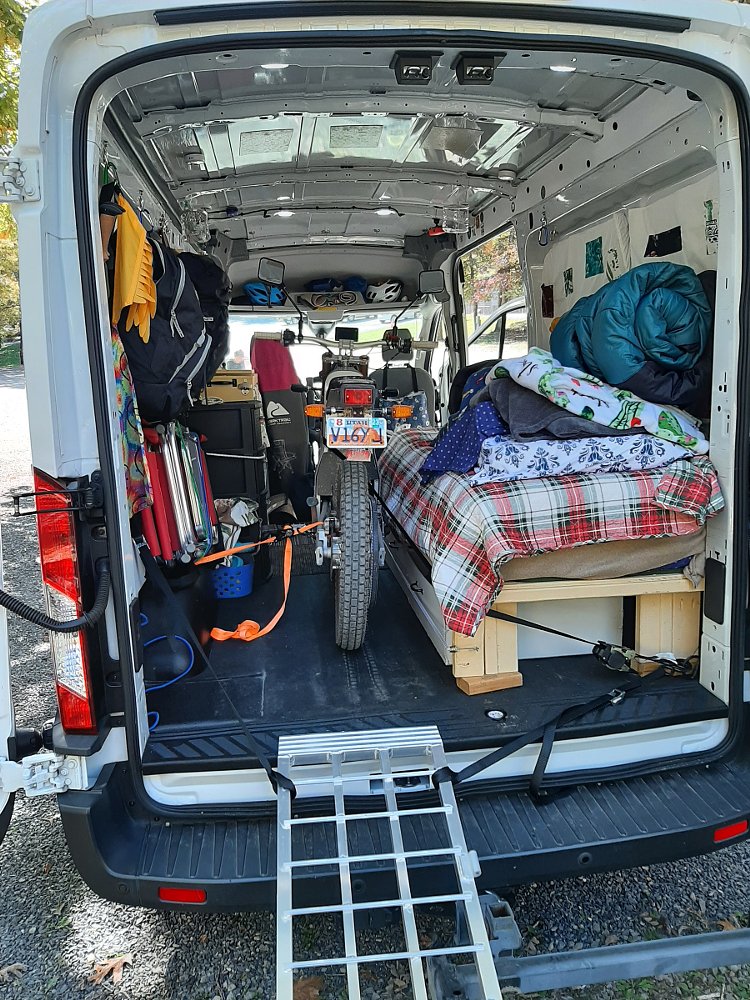
The following weekend I loaded the Kalk& into the van and went up to the Green Ridge State Forest in Allegheny County, Maryland. Green Ridge is an undeveloped area where dual-tracks and Jeep trails link 100 primitive, deep-woods camping areas. The riding surfaces cover the gamut of off-road riding — nice gravel, not nice gravel, mud, water crossings, areas that clearly were under water very recently, huge rutted grades littered with baby head rocks, and a surface I haven't seen anywhere else, where layers of underground sandstone intersect the road surface at a 45-degree angle, resulting in a surface that resembles riding across the edges of the pages of an enormous book. There’s washboard and then there's this stuff — your suspension had better be set up and working.
It's spectacular riding county and the Kalk& was in its element. I always felt completely in control, regardless of whatever the tracks threw at me. Working my way up some of the big grades on Kasecamp Road, the Kalk& felt just like a goat. The bike porpoised underneath me as it torqued up the grade, but there wasn't any wheelspin to speak of. It was equally surefooted on descents, which those in the know will tell you is where the real trouble lies. Brakes at both ends were easy to modulate and when it was time to just let the Kalk& roll, it tracked like a razor. Riding silently in these woods meant the deer I came upon were not in maximum freakout, and I could hear the bird songs and insects. After a 15-mile loop in the backcounty, which included everything from muddy bogs to hillclimbs, I worked my way back to camp on Dug Hill Road, which offers mile after mile of dirt-road switchbacks that call to one's inner flat-tracker.
After more than 30 miles of reasonably spirited off-road riding, I got back to camp, ready to kick back with a beer and a campfire. As off-road riding days go, this had been a more than pretty good one.
Price, range, and benefits: The CAKE calculus
Another rhinoceros in the room is the price of the CAKE Kalk&. At $14,860, it's expensive, particularly for a motorcycle with a limited use portfolio. It's hard to find a direct competitor that's currently available in the U.S. market to use as a basis of comparison, however. The Sur-Ron X is a lightweight electric motorcycle others look to for off-road riding and it only costs $4,400, but it has a little less range, lower top speed, and &mdash critically, for many riders — it's not street-legal. On the street-legal side there's the Zero FX, which is street-legal, has a much higher top speed, longer range, and costs almost $2,000 less, but it also weighs 100 pounds more. And neither of those bikes has suspension that compares to the pieces on the Kalk&.
What you get for your nearly $15,000 investment is a lightweight electric motorcycle of very high specification — surefooted, powerful, and easy to handle in sketchy conditions. It gets you a silent way to explore remote country, and to help to preserve the nature you’re riding though. It gets you a machine from a designer that sweats tiny details, and that will have you in the garage at the most unexpected times, just looking on in wonder at the thing. As an around-town short hop machine — got a four-mile ride to work? — it's the most agile, low-impact, powered vehicle imaginable.
What it doesn't get you is speed on the road (its cornering manners beg for a tiny café racer cousin with taller gearing) and it sure doesn't get you operating range.
You also have to be a self-reliant type to buy a CAKE, since you order straight from the manufacturer and the warranty specifically excludes off-road use or damage from a crash.
All that probably adds up to making the CAKE Kalk& the right choice for a fairly narrow slice of the motorcycling public. But if you are lucky enough to have an environment where you can ride the thing — or an easy way to get the bike to those places — then CAKE's Kalk& is an environmentally responsible motorcycle that is beautifully designed, tremendously capable, and a whole, whole lot of fun. The future might not be so bad, after all.
| 2022 CAKE Kalk& | |
|---|---|
| Price (MSRP) | $14,860 |
| Motor | Interior permanent magnet |
|
Transmission, final drive |
Single-speed, belt |
| Claimed horsepower | 13 |
| Claimed torque | 186 foot-pounds |
| Frame | Aluminum |
| Front suspension | Öhlins 30 mm inverted fork, adjustable for low- and high-speed compression and rebound damping, preload; 8.0 inches of travel |
| Rear suspension | Öhlins TTX22 shock |
| Front brake | Single four-piston caliper, 220 mm disc, no ABS |
| Rear brake | Single four-piston caliper, 220 mm disc, no ABS |
| Rake, trail | 25.0 degrees, 3.5 inches |
| Wheelbase | 51.5 inches |
| Seat height | 35.75 inches |
| Claimed range | 52 miles city/21 miles highway |
| Claimed battery capacity | 2.6 kWh |
| Claimed charge time | 0-80%, 2 hours; 0-100%, 3 hours @ Level 1-2 |
| Tires | Town&trail 19-inch front and rear |
| Claimed weight | 174 pounds |
| Available | Now, directly from the manufacturer |
| Warranty | 24 months (excludes off-road use) |
| More info | ridecake.com |











